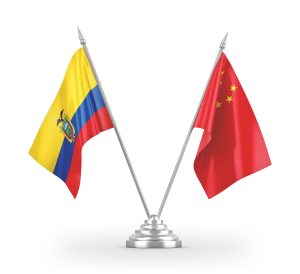After four rounds of negotiations and dozens of technical meetings, the Chinese and Ecuadorian teams successfully closed negotiations on a free trade agreement (FTA) between the two countries at the technical level.
The FTA was negotiated over the course of 10 months, following the roadmap set out by Ecuadorian President Guillermo Lasso during his official visit to Beijing in February 2022. The roadmap focused on reducing tariffs to allow market access and also included trade policies such as rules of origin, improvement of customs procedures and trade facilitation, trade defense, protocols for sanitary and phytosanitary measures, reduction of technical barriers to trade, investment cooperation, promotion of e-commerce, competition, transparency, dispute settlement, and economic cooperation.
The entry into force of this trade agreement will allow preferential access for 99 percent of Ecuador’s current exports to China, mainly agricultural and agro-industrial products such as shrimp, bananas, roses and flowers, cocoa, and coffee, among the main ones. It will also open the doors to exports of non-traditional exports from Ecuador, such as pitahaya, pineapple, mango, blueberries, processed foods, fresh and canned fruit, and a large number of other agricultural and agro-industrial products.
The FTA will improve access for Ecuador’s exports to a market of more than 1.4 billion consumers, thus boosting exports, employment, economic growth, and investment.
Currently, joint trade between Ecuador and China is worth over $10 billion. Until the first half of 2022, China was Ecuador’s main non-oil trade partner.
The trade agreement with China has foreseen sensitivities in the agricultural and industrial sectors, establishing a significant number of exclusions, particularly in the area of manufacturing, as well as long tariff reduction periods.
On the other hand, tariff-free access for raw materials, inputs, tools, and equipment reduces production costs for Ecuadorian industry and will offer greater variety and quality for Ecuadorian consumers.
This agreement establishes mechanisms in the sanitary and phytosanitary field to speed up market access processes. It also includes provisions on trade defense and trade facilitation that enable the possibility of establishing measures to protect Ecuadorian industry and implement a better exchange of information.
The productive sector in Ecuador participated actively in the negotiation, providing inputs and information to strengthen the negotiating team’s strategy.
The signing of the Ecuador-China Free Trade Agreement will take place after the completion of the respective processes of formalization of the offers, translations, and legal review. The date will be announced by both governments in due course.
Relations between the two countries are long-standing and deepened especially during the government of leftist Rafael Correa (in office 2007-2017), who turned to China after Ecuador defaulted on its international debt and ran out of foreign credit.
China thus managed to position itself as Ecuador’s main creditor. Most of the Chinese credit has gone to financing six hydroelectric projects worth $3 billion. Part of the debt was also linked to future oil sales. PetroEcuador, the government company, has been supplying oil to China’s state-owned PetroChina at a discount as part of Ecuador’s debt repayment.
In September 2022, with Guillermo Lasso in power, Ecuador managed to restructure a portion of the Chinese debt, which amounted to $4.4 billion. The agreement was reached directly with China’s policy banks, the China Development Bank and the Export-Import Bank of China, which together have provided more than $18 billion in loans to Ecuador since 2010.
The debt restructuring is a paradigmatic case for other Latin American countries, such as Argentina and Venezuela, which could follow suit with respect to Chinese debt.
In addition to loans from Chinese state-owned banks and politicians, Ecuador was the first Latin American country to receive financing from the Chinese-controlled Asian Infrastructure Investment Bank.
Prior to beginning talks with Ecuador, China had already signed a number of free trade agreements in the region, most notably with Peru, Costa Rica, and Chile. The FTA with Chile came into force in October 2006; with Peru in March 2010; and with Costa Rica in August 2011.
So far, China’s objective seems to be to establish preferential trade relations with countries that look toward the Pacific, as evidenced by the talks it has held with Colombia and El Salvador, for example.
The most striking case is that of Uruguay, where there have already been certain announcements and technical meetings with a view to a possible FTA, which would be in line with China’s approach toward Latin America. According to Uruguayan specialist Ignacio Bartesaghi, “geopolitically, it is very convenient for China to sign an FTA with Uruguay.”
Ecuador is China’s next step in Latin America; it remains to be seen which country will come after that.
This piece was originally published in Spanish by ReporteAsia.

































